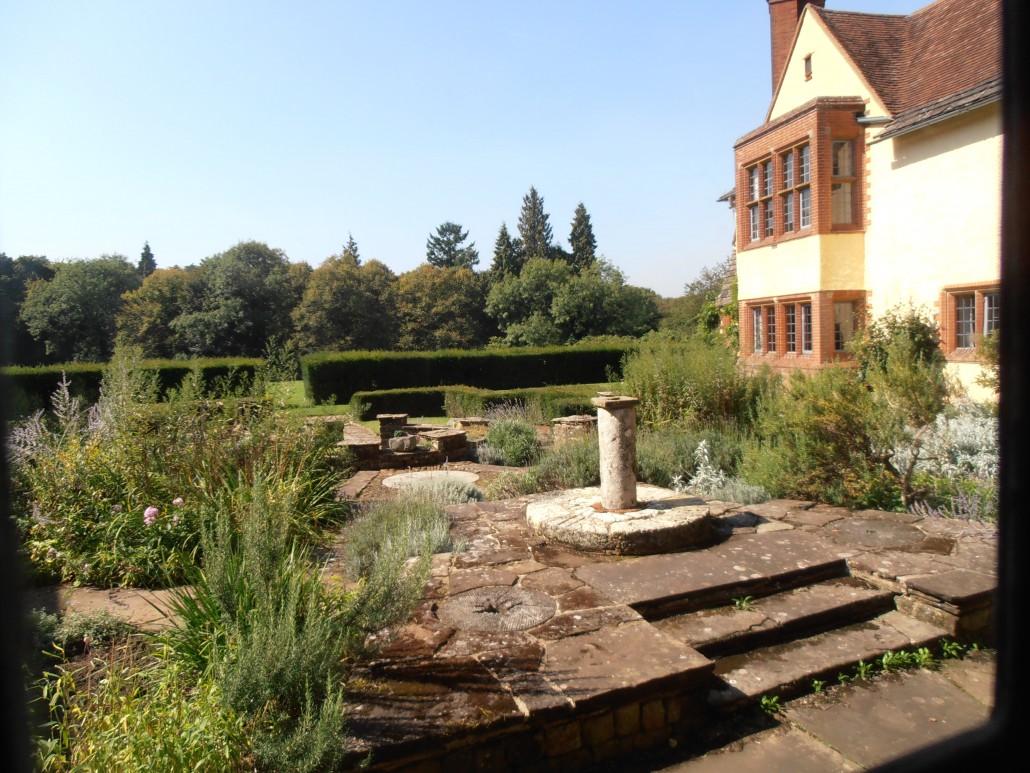Goddards, Abinger Common
Goddards Study Day
Wednesday 17 June 2009
This year we were lucky to have two talks, instead of one, both given by our memorial ‘sleuth’ Tim Skelton, whose recent book, Lutyens and the Great War, has done so much to record and describe all the Lutyens war memorials on the Western Front as well as the civic memorials in Britain.
In the morning Tim started with Lutyens’s private memorials, a third of which were unrecorded before his pioneering work over the years – so it was riveting to see the examples he showed us as only a handful had been published before. No two memorials are the same, although as Tim demonstrated, they can be classified into different types. There is the Cenotaph model and the tomb chests, often with undercut bases, some in the form of crosses, like Lord Brownlow’s tomb at Belton (1927).
The McKenna family tomb at Mells (1932), with its abstract interlocking forms, also shows how the surrounding planting – the four oaks around the tomb – often played a part in the design. Then there are the flat grave stones and the plain vertical slabs. Tim discovered, for example, that the Dion Boucicalt headstone of 1929 is not in Henley Churchyard as stated in the Hussey Memorial list, but in Hurley Village five miles away. And often, as he showed us, the headstones and tombs include sculpture, which could form a fascinating subject in itself to establish which sculptors Lutyens used in his work.
Understandably, many civic memorials took the form of crosses, but I don’t think we realized, before Tim’s work, just how many towns and villages used Lutyens’s own version of the cross – the reduced and spare Celtic cross rather than the Calvary shape. Private crosses, however, were often designed differently – shown, for example in the very fine and tapering version to Lord Rhondda (1922) at Llanwern. This cross is included in Pevsner but is not attributed to Lutyens, as is often the case.
Some memorials take the form of structures, like the Hannen Columbarium at Wargrave, or burial enclosures, like the completely unknown James Fletcher Memorial at Avoch on the Black Isle. This one I had seen, after battling through undergrowth! It consists of a circular enclosure, very elemental, with a cross suspended at its entrance.
At the end of his first talk Tim showed us the Lutyens sketches for Lord Northcliffe’s memorial in St. Marylebone Cemetery, which the Trust purchased recently and has given to the RIBA Drawings Collection. They are fascinating in showing how Lutyens drew his ideas on his virgin pad, or squared paper, ideas which were often recycled for different projects.
After lunch Tim continued with his second talk on ‘Lutyens and the Western Front’, describing first how the memorials and cemeteries were conceived and then Lutyens’s involvement with the junior architects in his own design ‘team’, which he supervised. Under his guidance the cemeteries, with his Great War Stone and Cross of Sacrifice by Blomfield, and with the pavilions, walls and steps, were treated as works of architecture. Seeing so many images, it was possible to see the sheer variety of styles and materials: from the primitivist stone of Truelove’s Klein Vierstraat cemetery in Belgium to the subtlety of Goldsmith’s La Neuville near the Somme, which must surely be by Lutyens himself. Tim ended with the War Stone, Lutyens’s ‘altar’ placed in each cemetery, and which he felt had been overlooked as one of the best things he had ever done – anywhere.
Tim gave us two splendid talks, generously sharing his discoveries with us. I hope he will publish a second volume on the private memorials.
Later in the afternoon we went on two visits, organized by Janet Allen. First to Busbridge Churchyard to see the Lutyens War Cross, the Jekyll tombs with their Sanchi railings, Julia Jekyll’s gravestone, which is rather neglected, and by contrast, the Francis McLaren memorial with its oak headboard, beautifully restored. Then on to Thursley where the group visited The Corner, Lutyens’s first job, and to Prospect Cottage, formerly the Village Institute, by permission of Mrs. Barbara Richmond, where they saw Lutyens’s original design for the building (from the Parish Archive), and then next door where Sallie Roles kindly provided tea and where they also saw early photographs of the Institute (also from the Archive). Then to Thursley Churchyard to see the memorials to his mother and to his nephew, Derek. A good ending to a day devoted to Lutyens’s memorials.
M.R.



